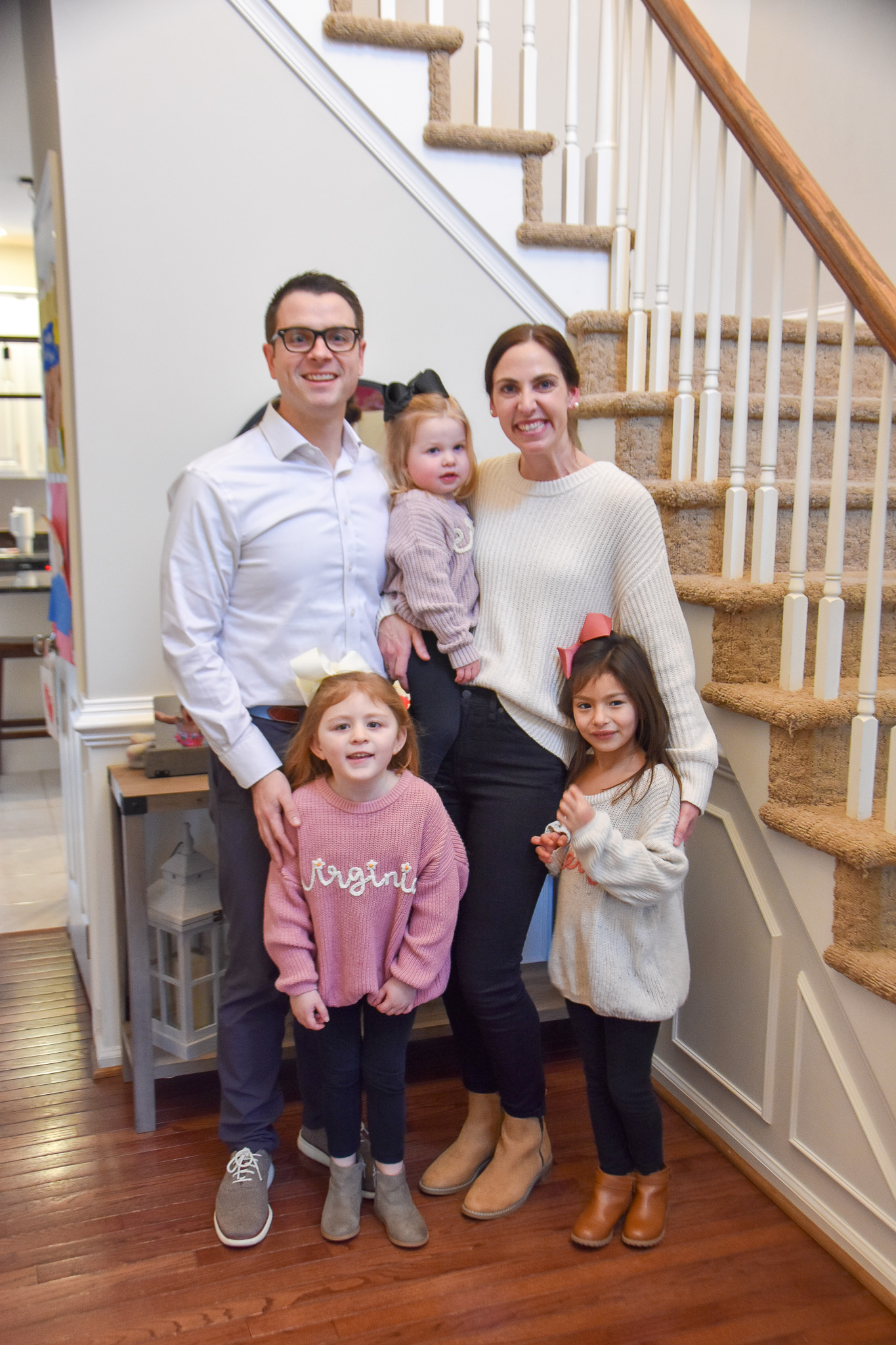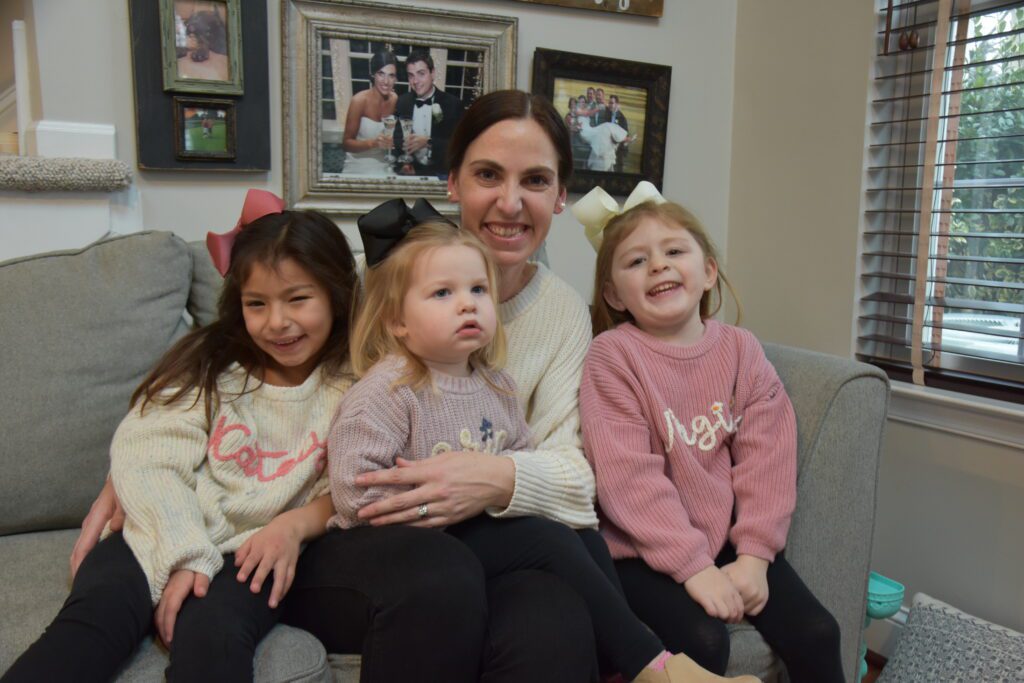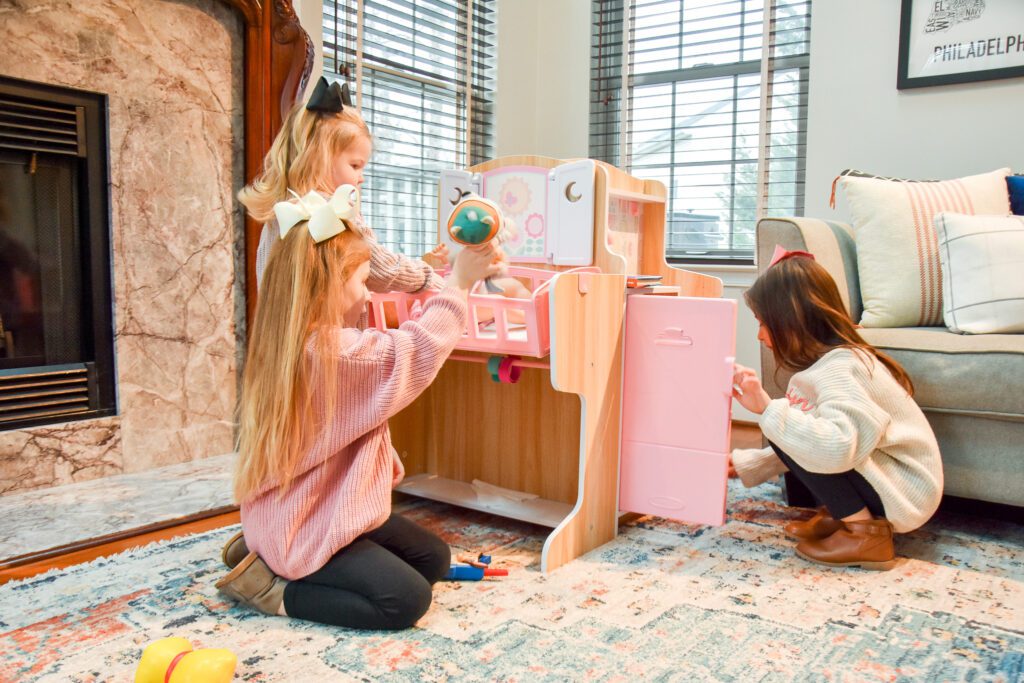
At just seven months old, Virginia underwent an early intervention services evaluation for not meeting milestones, but now she's thriving.
By Sydney Kerelo

The Bruce family // Photo by Aubrey Hoffert
With bright, long blonde hair and a beaming smile, Virginia Bruce ran around her Pennsylvania home with her two sisters, laughing at each other over baby dolls and bounce houses. As she giggled with her sisters, one would never have imagined that she had a developmental delay and spent the first few years of her life receiving early intervention services.
At just seven months old, Sheila Bruce’s daughter Virginia underwent several evaluations because she was not meeting certain milestones, like rolling over or sitting up unsupported. She was diagnosed with a delay and was referred to KenCrest’s Early Intervention program, where she received physical therapy, occupational therapy, and speech therapy, and had a specialized instructor.
“Virginia was adopted at birth and had some initial health things going on, so we did have an understanding that we should keep an eye on her development,” says Bruce of her now five-year-old daughter. “She wasn’t engaged with us; you could walk out of the room, and she wouldn’t know. One year, during a family vacation, everyone kept commenting about how she was such a good baby, sitting there playing and was content, and it hit me. I was like, wait, she shouldn’t be sitting there so content.”
That thought sparked something in Bruce; she knew it was time to get her evaluated. Soon, the family was matched with an interventionist from KenCrest who came to the house and started first with physical therapy and then gradually introduced other forms of treatment like occupational and speech therapies.
“Intervention was beneficial for us in all the different areas. They showed us different ways to engage with her through play and to get on Virginia’s level. To let her take the lead in playing and not worry so much about functional play skills but just ways to help her elaborate on her play to let us join in.”
Sheila Bruce
Beginning Her Journey With Early Intervention Services
According to Bruce, it was incredibly daunting, at first, to think of what her daughter had to undergo, but with KenCrest’s support, it grew easier.
KenCrest’s Early Intervention services collaborate with parents and caregivers to identify development concerns and implement strategies to help each child thrive. The approach to intervention is a coaching model that simultaneously works with both the child and the parents to develop strategies and techniques to help both the parent and child thrive.
“I feel like working with our interventionist gave us the skills and the tools that we needed to be able to help her confidently when they weren’t there with us,” says Bruce. “Speech early on was very helpful, and we learned that communication is more than just verbal. I remember pushing her on the swings, saying, ‘Three, two, one,’ and then waiting for her to look at me. If she made eye contact, I took that as the initiative to let go of her swing. It got to the point where I wouldn’t even get to the sound for ‘Go’ before she would make eye contact with me. Now, she doesn’t need any prompting and will scream go at me.”

“Intervention was beneficial for us in all the different areas,” adds Bruce. “They showed us different ways to engage with her through play and to get on Virginia’s level. To let her take the lead in playing and not worry so much about functional play skills but just ways to help her elaborate on her play to let us join in.”
In 2020, Virginia was officially diagnosed with autism shortly after she turned two years old and discovered she had a genetic mutation in one of her genes that is unique to just her. It was initially terrifying for the family, but with KenCrest’s support, it didn’t seem so scary.
From Early Intervention Services to Kindergarten
Now, at five years old, Virginia is preparing to start kindergarten, and while she will still need ABA support, she has come a long way from where she began.
As a mother to a daughter who is neurotypical, it was incredibly daunting and scary to think about what the future holds. But while it’s scary, there is so much beauty in it.
“There’s a poem that I hung up on my fridge for a very long time called, ‘Welcome to Holland,’” says Bruce. “It talks about how you are getting ready to take a trip to Italy; you prepare, and you're so excited, but you get on the plane, and the flight attendant says, ‘Welcome to Holland.’ At first, you are taken aback, and it is not that Holland is this terrible, ugly place but that it is different than what you expected. All your friends are in Italy going to flashy parties, and it's bright and fast, but you're in Holland, where it's just a little bit slower. If you spend your whole life upset that you're not in Italy, you can't enjoy what Holland offers. It’s a good reminder to take things one step at a time and that it's ok to grieve the life you thought you would have but that you must enjoy it because although it's different, it’s still wonderful.”
While Bruce struggled at first with Virginia’s diagnosis, she has come to accept it and love every aspect of her daughter’s life. Virginia has come a long way from where she started; she is incredibly social and loves to be active now by doing gymnastics or playing at the park. Her favorite things are running around the playground, sliding down the slides, or swinging on the swings. The family even has a blow-up bounce house in their basement.

Virginia has two sisters, an older one, Katelyn, and a younger one, Erin, who adore one another. At first, Bruce worried that Virginia and her other daughters wouldn’t ever play together. But now they’re thick as thieves, constantly playing pretend together or having sleepovers in each other’s room. She loves them, and they love her just as strongly.
Her older sister, Katelyn, is her biggest protector; she’s quick to defend Virginia if she thinks someone isn’t being kind. She understands that her brain works differently and makes sure that she is treated fairly.
Two years ago, Bruce joined KenCrest’s board because of the support she received when Virginia was first diagnosed. She wanted to pay it forward, help other families going through early intervention, and offer them the same support she received because it helped them grasp the tools and knowledge necessary to make their child progress.
“They came to our house and made it a whole family thing,” says Bruce. “It felt like we were all in this together as a team, and we felt like there were other people out there who truly cared about our child’s progress. Early Intervention services are responsible for much of Virginia's progress, and we would not be here today without it.”
